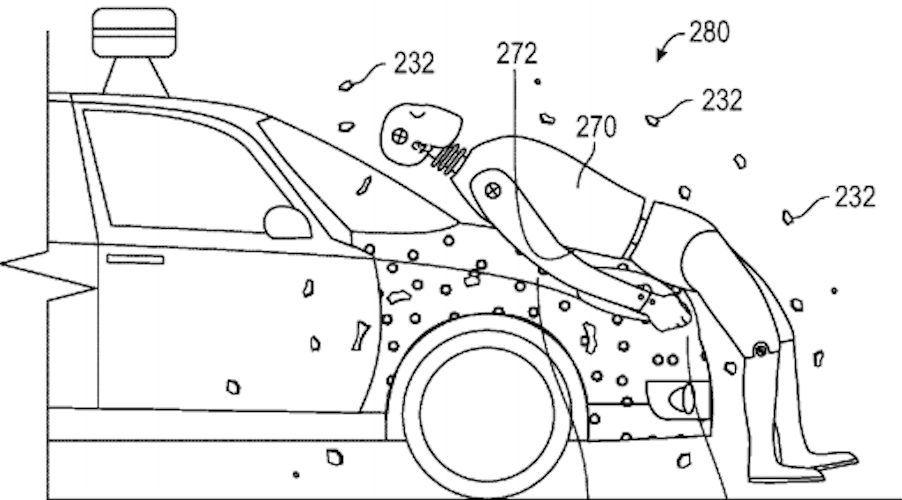[youtube_sc url=“https://www.youtube.com/watch?v=ULOUSKqDSYo”]
“Airbus has filed a patent for the world’s fastest helicopter.”
[youtube_sc url=“https://www.youtube.com/watch?v=ULOUSKqDSYo”]
“Airbus has filed a patent for the world’s fastest helicopter.”



In a blog post today, Uber showed off the self-driving car that’s been stealthily cruising around Pittsburgh. The car is a hybrid Ford Fusion and is currently in early stages of safety testing. This particular Uber test vehicle was first spotted almost a year ago by local Pittsburgh media, but this is Uber’s first acknowledgement of such tests.
Uber and Google (among others) have been racing to be the first to develop self-driving taxis for over a year now. Uber “cleaned out” Carnegie Mellon and the National Robotics Engineering Center to be part of its Advanced Technology Center in Pittsburgh, the research arm responsible for developing this “look ma, no hands” technology. This heavy hiring out of Carnegie Mellon could give Uber a big boost. The Pittsburgh-based university considers itself the birthplace of self-driving cars, and it probably is. CMU researchers were testing autonomous vehicles before Google even existed.
In March, Uber also joined a coalition, this time in partnership with Google, to advocate for self-driving adoption.

New and improve fuel cells.
Fuel cells, which generate electricity from chemical reactions without harmful emissions, have the potential to power everything from cars to portable electronics, and could be cleaner and more efficient than combustion engines. Abstract: Fuel cells, which generate electricity from chemical reactions without harmful emissions, have the potential to power everything from cars to portable electronics, and could be cleaner and more efficient than combustion engines.

Nice.
NILES, Ill., May 18, 2016 /PRNewswire/ — MicroLink Devices is proud to announce that Airbus Defence and Space has issued a production contract for MicroLink’s epitaxial liftoff (ELO)-based multijunction solar sheets for use on the new Zephyr S platform.
Photo — http://photos.prnewswire.com/prnh/20160517/368562

If today’s aviation advances aren’t moving fast enough for you — tray table technology hasn’t budged in decades — you’ll want to check out the futuristic visions of Spanish industrial designer Oscar Viñals.
The Flash Falcon is a future concept jetliner powered by portable fusion reactors. That technology isn’t here yet, of course, but Viñals kind of specializes in “what if?” scenarios.
Tasty Tech Eye Candy Of The Week (May 15)


I do see delays of self-driving 18 wheelers across the US. Too many laws & regulations would need to change, consumer safety & protection advocacy groups, etc. will delay this in the US.
SAN FRANCISCO – Picture an 18-wheel truck barreling down the highway with 80,000 pounds of cargo and no one but a robot at the wheel.
To many, that might seem a frightening idea, even at a time when a few dozen of Google’s driverless cars are cruising city streets in California, Texas, Washington and Arizona.
But Anthony Levandowski, a robot-loving engineer who helped steer Google’s self-driving technology, is convinced autonomous big rigs will be the next big thing on the road to a safer transportation system.

WEST LAFAYETTE, Ind. – A new highly efficient power amplifier for electronics could help make possible next-generation cell phones, low-cost collision-avoidance radar for cars and lightweight microsatellites for communications.
Fifth-generation, or 5G, mobile devices expected around 2019 will require improved power amplifiers operating at very high frequencies. The new phones will be designed to download and transmit data and videos faster than today’s phones, provide better coverage, consume less power and meet the needs of an emerging “Internet of things” in which everyday objects have network connectivity, allowing them to send and receive data.
Power amplifiers are needed to transmit signals. Because today’s cell phone amplifiers are made of gallium arsenide, they cannot be integrated into the phone’s silicon-based technology, called complementary metal-oxide-semiconductor (CMOS). The new amplifier design is CMOS-based, meaning it could allow researchers to integrate the power amplifier with the phone’s electronic chip, reducing manufacturing costs and power consumption while boosting performance.